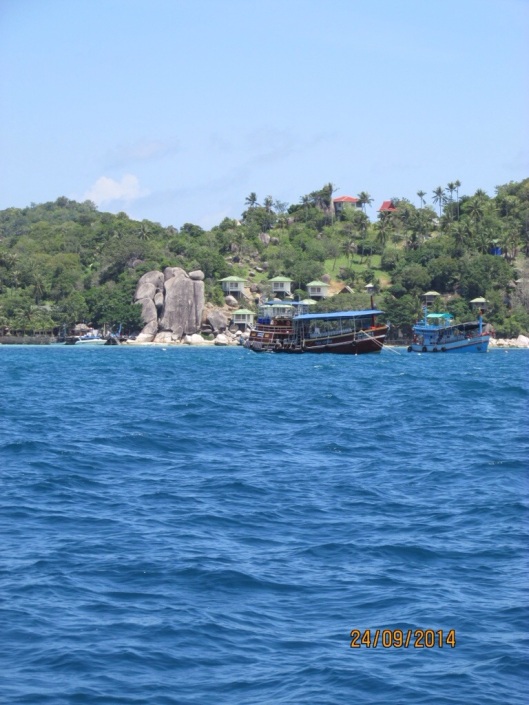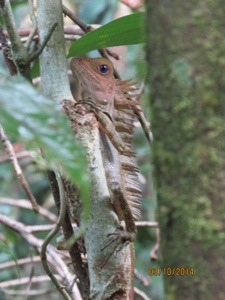Spending close on two weeks in Bangkok, nearly made me feel like a local. Started getting the hang of the BTS (an acronym for Bangkok Transport System, but I much prefer Big Train in the Sky) and saved a lot of travelling time by hopping on to the back of one the many motorbike taxis that duck and dive through the unrelenting traffic. My newfound friend Nicky, who I met in Cambodia and teaches in Bangkok introduced me to the little red local bus, where a ticket costs a mere 7 baht (+/-R2.50) and the water taxi on the Khlong Saen Seap, a canal that runs through central Bangkok. You have to be quite adept when jumping on to the longboat, that screams up to the jetty, 4 youngsters with helmets and thick gloves jump off, secure the vessel and give you just enough time to hop on and off you go again. Great way of getting around the city.
But now it was time to move on. I’d had the requisite hair cut, facial and pedicure.
Call me ignorant, but I had never heard of Kanchanaburi. And it took me a while to find it on the map of Thailand.

The youngsters I was staying with in the City that Never Sleeps were heading there to run a half marathon, and it is literally only a 2 hour drive to the west of Bangkok close to the Myanmar border and lies on the River Kwai. Now that I had heard of!! It has a heartbreaking World War 2 history. Over 100 000 labourers (16 000 British, Australian and Dutch POW and 90 000 Asians) perished here building the Death Railway for the Japanese during 1942/43, and today 6 982 headstones in a beautifully maintained cemetery are poignant testimony to the horrors of war.
And of course one has to take a walk on the Bridge over the River Kwae (or Kwai of Hollywood fame) which was part of the Japanese Death Railway.
And I was also very lucky to meet the ultimate travellers Paul and Debbie from England in Kanchanaburi. They have been on the road for more or less the last 3 years. I identified with them because we are of similar age and they also seem to travel by the seat of their pants. As a solo traveller I am usually the one that would initiate a conversation, so it was refreshing to have Paul approach me and ask whether they could join my table. We swapped a multitude of travel tales and drank copious beers, and I have subsequently chuckled about Paul’s highly entertaining blogs.

And it was on their recommendation that I added Kuching to my travel destinations.
Travelling in Thailand is really a breeze. The roads are good, the buses are world class (albeit gaudy), you can book seats online and leave more or less on time. My onward trip took me by nightbus to Chumphon and then by ferry to the idyllic island of Koh Tao. The last time I scuba dived was in 2001, and this was the ideal opportunity to update my qualification. There was a dive school attached to the Montalay Resort where I was staying on the other side of the island, and after brushing up on the theory, writing a little exam and doing 3 dives they issued me with a valid PADI ticket. This now opens up a whole new world of travel opportunities!!
I would have loved to have languished here for a little longer, and an inertia had settled over me, but paradise is costly, so onwards and southwards. Malaysia calls. I had only a very vague idea of where to, but once I was on the road again, I was sure I would get inspired. The Perhentian Islands just off the Malaysian coastline in the Gulf of Thailand sounded enticing, hence my booking a ticket on the night train to the Thai border town of Su Ngkai Kolok. Only 40 km across the border was the town of Kota Bharu, from where it was just a short ferry ride across to the islands, or otherwise Kota Bharu also had an airport from where I could fly to Kuching on the island of Borneo, as suggested by Paul and Deb.
Decisions, decisions!!
My friend Nicky put a flea in my ear and raved about diving off Sipadan in the Semporna Archipelago (that’s off the coast of Malaysian Borneo, in case you are wondering) and after some research this became a very strong contender.
According to our bible, the Lonely Planet discouraged the border crossing of Su Ngkai Kolok because of ongoing violence in Thailand’s Deep South, but this was probably the easiest border crossing I have experienced so far.
The train station was not more than one kilometer from the border, and I was joined by two young Danish girls and we walked the distance, got our exit stamp out of Thailand, walked across to the Malaysian immigration building and within minutes and not a dollar passing hands I was in possession of a 3 month tourist visa.
The grubby little town of Kota Bharu was largely forgettable, and the only reason I hung around for 3 days, was because I had decided to skip the Perhentians and head for Borneo instead. There were only three flights a week to Kuching, earliest being three days hence. This gave me chance to read up a bit on Borneo, of which I knew bitter little. I did not even know that there was a Malaysian and Indonesian part to the island and that this is where I would find the unimaginably rich Sultanate of Brunei.
It is the third largest island in the world and has one of the oldest rain forests in the world, in which you will still find orangutans and a whole host of other exotic primates, animals and birds.
Malaysian Borneo consists of two states Sarawak, with the capital of Kuching, and Sabah, and its capital of Kota Kinabalu. A few hours drive from there you will find the highest mountain in Borneo, the 4000 meter+ Mount Kinabalu.
Kuching is a delightful little riverside town on the Sarawak River. What I found fascinating was that Sarawak was gifted to the English adventurer James Brooke for quelling an uprising of local tribes by the Sultan of Brunai, and three generations of Brooke’s ruled this territory until the Japanese invaded Borneo in 1941.
Kuching means “cat” in Malay, and stubby tailed cats abound in and around the city.
I was desperate to see the Borneo Orang Utans, so headed to the Semenggoh Rehabilitation Centre, where 27 semi wild primates reside in a huge jungle reserve. Every day at 9 in the morning and 3 in the afternoon the wardens put out food to supplement the fruit they can get in the wild, but they made it abundantly clear that they could not guarantee a sighting at these feeding stations, and sadly as it is fruiting season at the moment we waited in vain both morning and afternoon for these gentle giants to arrive. Well, it’s not a zoo, so one has to be philosophical about it.
Did see some scaly critters though:
I also took a trip out to a cultural village which, although all a bit “tommy tourist” did give you a good insight into the lives of the the indigenes of Borneo. There are several tribes and in days gone by they were hunter/warriors, living as a community in longhouses. They practiced head hunting and although this was outlawed by James Brooke in the 18hundreds you still see reminders of this to this day.

This photo was taken at the authentic Badaiyuh longhouse village of Annah Rais.
Today I took the one hour flight from Kuching to Kota Kinabalu, or KK, as the locals call it. On the 16th of October I plan on heading out for a once-in-a-lifetime experience of diving off the Semporna Archipelago; Sipidan being the highlight. It will cost me an arm and a leg, but I have come too close to not take the plunge.
In the meantime I might climb the intimidating Mount Kinabalu, or just hike the surrounding national park. I am yet to decide. But, me thinks, it will give me enough material for the following blog!!











still very entertained dear Sybbie by your travels! look forward to reading each and every word! xx
Lovely blog. Will think of you tomorrow at our Captains dinner. xx
Loving reading about your travels from a hot and windy Joburg. Your adventures and travels are wonderful to read about.
Travel writer could be your next job description – great armchair travel!
Oh pal… great to catch up on the detail of your travels… and soooooo very proud of you for redoing your diving qualification and also to know that you’re soon to be diving in Sipidan….. you will not be disappointed… I promise!!!!!